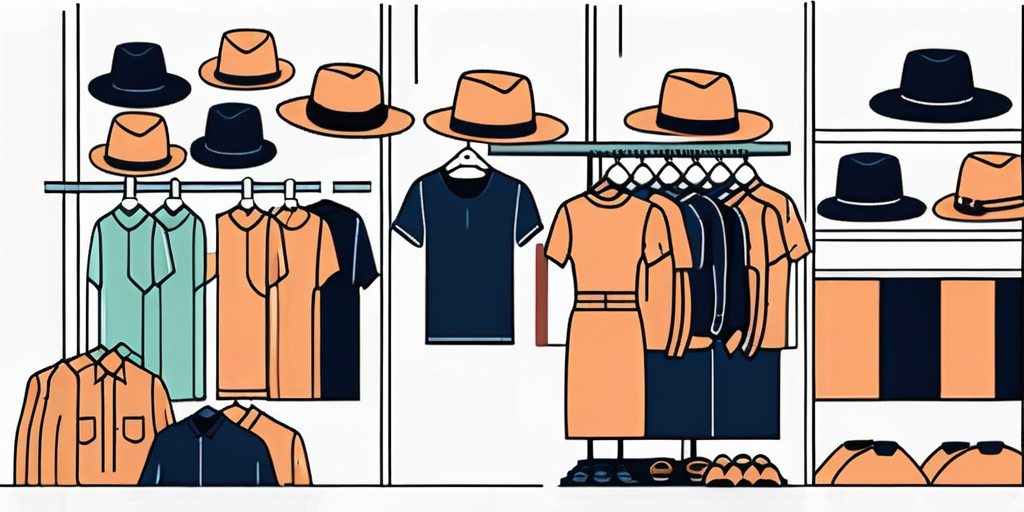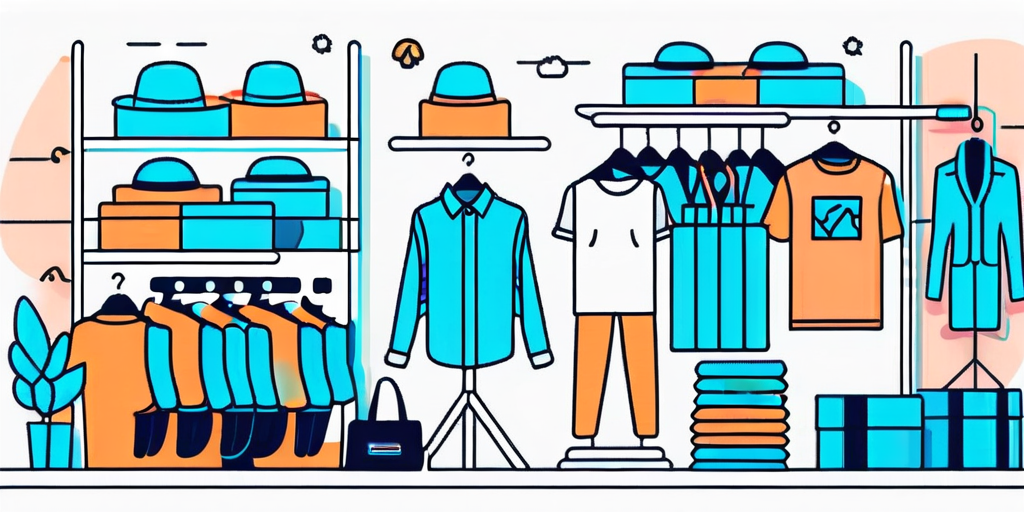In this comprehensive guide, we will explore the world of clothing dropshipping and provide you with all the information you need to start your own successful business in this lucrative industry. Whether you are a seasoned entrepreneur or just starting out, this guide will take you through the essential steps to set up and run a clothing dropshipping business.
Understanding the Basics of Dropshipping
Before diving into the world of clothing dropshipping, it is crucial to have a solid understanding of what dropshipping actually is. Dropshipping is a business model in which you don’t need to stock inventory yourself. Instead, you partner with suppliers who will handle the storage, packaging, and shipping of products directly to your customers.

What is Dropshipping?
Dropshipping is a retail fulfillment method where the store doesn’t keep the products it sells in stock. Instead, when a store sells a product, it purchases it from a third party and has it shipped directly to the customer. The store owner never sees or handles the product.
Benefits of Dropshipping
One of the main advantages of dropshipping is that it eliminates the need for inventory management and the associated costs. You don’t have to worry about stocking and storing products, which saves you both time and money. Additionally, dropshipping allows you to offer a wide range of products without the need for upfront investment.
Another benefit of dropshipping is the flexibility it offers. Since you don’t have to invest in inventory upfront, you can easily test different products and niches without significant financial risk. This allows you to adapt and pivot your business based on market trends and customer preferences, ensuring that you stay ahead of the competition.
Challenges in Dropshipping
While dropshipping has many benefits, it’s important to be aware of the challenges that come with this business model. Some of the common challenges include intense competition, shipping delays, and potential issues with product quality. However, with proper planning and execution, these challenges can be overcome.
Intense competition is a reality in the dropshipping industry. With low barriers to entry, many entrepreneurs are attracted to this business model, resulting in a saturated market. To stand out from the competition, it’s crucial to differentiate your brand by offering unique products, exceptional customer service, and effective marketing strategies.
Shipping delays can also be a challenge in dropshipping, especially when dealing with suppliers from different countries. It’s important to communicate clearly with your suppliers and set realistic expectations with your customers regarding shipping times. Building strong relationships with reliable suppliers can help minimize shipping delays and ensure a positive customer experience.
Lastly, product quality can be a concern in dropshipping, as you don’t have direct control over the products being shipped to your customers. To mitigate this risk, it’s important to thoroughly vet your suppliers and choose those who have a track record of delivering high-quality products. Regularly monitoring customer feedback and addressing any issues promptly can help maintain a positive reputation for your business.
Exploring the Clothing Niche in Dropshipping
Now that we have a good understanding of dropshipping, let’s dive into the world of clothing dropshipping. Why should you choose clothing as your niche in the dropshipping business?
Why Choose Clothing for Dropshipping?
Clothing is a highly popular and evergreen niche. People are always in need of new clothing items, making it a market with constant demand. Additionally, clothing offers a wide range of options, from casual wear to formal attire, allowing you to cater to different target audiences.
Trends in Clothing Dropshipping
To succeed in the clothing dropshipping business, it’s important to stay updated with the latest trends. Keep an eye on fashion magazines, social media influencers, and popular brands to identify emerging trends. By offering trendy clothing items, you can attract more customers and stay ahead of the competition.
Selecting Your Clothing Niche
When choosing your clothing niche, it’s crucial to consider your target audience. Are you targeting men, women, or both? What age group do you want to focus on? By narrowing down your target market, you can curate a collection of clothing items that resonate with your audience and make a strong impact.
One important factor to consider when selecting your clothing niche is the seasonality of certain clothing items. For example, if you choose to focus on swimwear, you may experience higher demand during the summer months. On the other hand, if you choose to specialize in winter coats and jackets, you can expect a surge in sales during the colder months.
Another aspect to keep in mind is the sustainability and ethical practices of the clothing brands you work with. With the growing awareness of environmental issues, many consumers are now seeking out eco-friendly and ethically produced clothing. By partnering with brands that align with these values, you can attract a niche audience that prioritizes sustainability.
Setting Up Your Clothing Dropshipping Business
Now that you have chosen clothing as your niche, it’s time to set up your clothing dropshipping business. Let’s explore the essential steps you need to take to get started.

Choosing the Right Suppliers
The success of your clothing dropshipping business heavily relies on choosing the right suppliers. Look for reputable suppliers with a wide range of clothing options, competitive pricing, and reliable shipping methods. Do thorough research and read reviews to ensure you partner with trustworthy suppliers.
When selecting suppliers, it’s important to consider their inventory management systems. Efficient inventory management ensures that your customers have access to a wide variety of clothing options at all times. Additionally, look for suppliers who offer real-time inventory updates, as this will help you avoid selling products that are out of stock.
Building Your E-commerce Store
Creating a professional and user-friendly e-commerce store is essential for the success of your clothing dropshipping business. Choose a reliable e-commerce platform that offers customizable templates and seamless integration with dropshipping apps. Design a visually appealing store and optimize it for a smooth shopping experience.
When designing your store, consider implementing features that enhance the customer experience. For example, you can include a size guide to help customers choose the right fit, or offer a virtual try-on feature that allows customers to see how the clothing will look on them. These additional features can help build trust with your customers and increase sales.
Pricing Your Products
When pricing your clothing items, it’s crucial to consider factors such as supplier costs, shipping fees, and market demand. Conduct market research to determine competitive pricing and ensure your profit margins are sustainable. Striking the right balance between affordability and profitability is key.
In addition to considering costs and market demand, it’s important to keep an eye on industry trends. Stay updated on the latest fashion trends and adjust your pricing strategy accordingly. Offering trendy clothing at competitive prices can help attract more customers and keep your business ahead of the competition.
Marketing Your Clothing Dropshipping Business
Now that your clothing dropshipping business is up and running, it’s time to focus on marketing. Effective marketing strategies will help you reach a wider audience and increase sales. Let’s explore some popular marketing techniques for clothing dropshipping businesses.

Social Media Marketing Strategies
Social media platforms such as Instagram, Facebook, and Pinterest are powerful marketing tools for clothing dropshipping businesses. Create engaging content, collaborate with influencers, and run targeted ads to increase brand awareness and drive traffic to your e-commerce store.
For instance, on Instagram, you can showcase your clothing items through visually appealing posts and stories. Collaborating with fashion influencers who have a large following can help you reach a wider audience and gain credibility. By running targeted ads on Facebook, you can reach potential customers based on their demographics, interests, and online behavior.
Email Marketing for Your Business
Email marketing is a cost-effective way to nurture relationships with your customers and encourage repeat purchases. Collect email addresses through opt-in forms on your website and send personalized emails offering exclusive discounts, new arrivals, and relevant fashion tips.
When crafting your emails, make sure to segment your audience based on their preferences and purchase history. This way, you can send tailored content that resonates with each customer. Consider including product recommendations based on their previous purchases or offering loyalty rewards to encourage customer loyalty.
SEO for Your Clothing Store
Implementing search engine optimization (SEO) techniques will improve your store’s visibility in search engine results. Conduct keyword research to identify popular search terms in the clothing industry and optimize your website accordingly. Focus on creating high-quality content and building backlinks to improve your SEO rankings.
One effective SEO strategy is to create a blog section on your website where you can share fashion tips, style guides, and industry news. By consistently publishing valuable content, you can attract organic traffic to your website and establish yourself as an authority in the fashion industry. Additionally, building backlinks from reputable fashion blogs and websites can boost your website’s credibility and improve its search engine rankings.
By following these steps and implementing effective marketing strategies, you can build a successful clothing dropshipping business. Remember to continually adapt and evolve your business to stay ahead of the competition and exceed customer expectations. Good luck on your clothing dropshipping journey!

